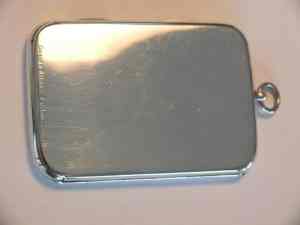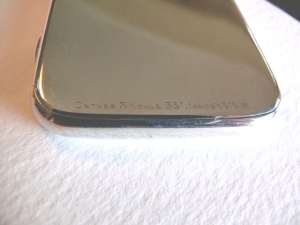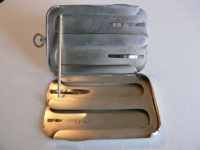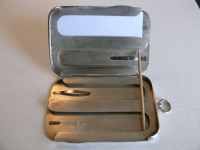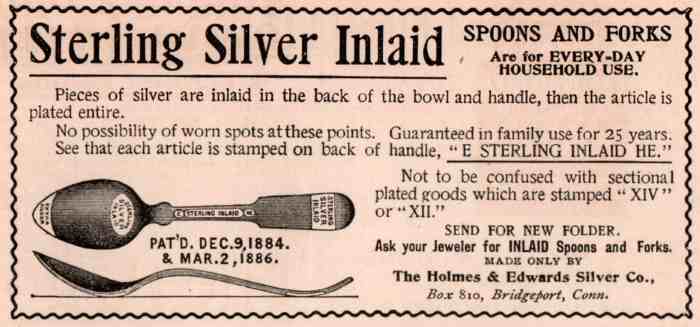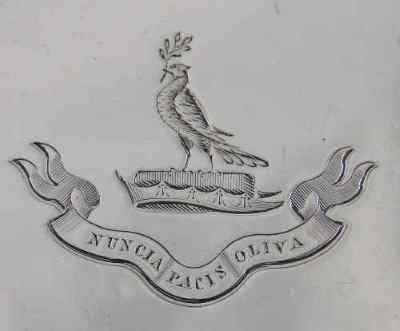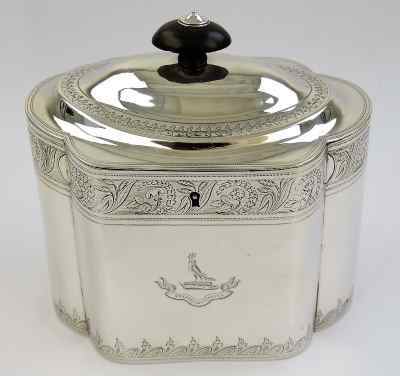 newsletter
# 154 March 2017
newsletter
# 154 March 2017www.ASCASonline.org SITE MAP
email: silverassociation@yahoo.it
YOUR GUIDE TO MARCH NEWSLETTER: articlesnew members members' windowmail to ASCAS replies to questions a page per month a silversmith per month a word per month a book on my shelf a crest per month contributors to this Newsletter search engine disclaimer and privacy policy A new article for ASCAS website
Patricia F. Singer presents:
|

Maurice Meslans presents:
|
Mail to ASCAS: e-mail
silverassociation@yahoo.itJanet lynne Hoets writes:
...I'd wish to have information about the marks on a silver tray I have.
Thanks in advance and kind regards,
Janet lynne Hoets
Janet lynne Hoets
Your tray has Austrian hallmarks, see my website at http://www.silvercollection.it/dictionaryetrogbox.html.
The "A" on the Diana mark corresponds to Vienna.
The other mark is the maker's mark of Karl Wurbel (born 1853), active 1890-1913. Mayer is the retailer.
Giorgio Busetto
Judith writes:
...Thank you for making a site that shares so much of information!
The reason that i am writing is that i have a strange object by Gorham - that was meant to be a picture frame but because of the space between the glass and the un steady leg - it has turned into a mystery that I can't seem to solve. And the leg seems not able to support the frame and actually looks as if it would slot into something (it's only 9cm high).
I just wondered if you give me advice where could get more information on the piece, I don't care about the value of the object. It's just not knowing what it is that is driving me crazy.
I thought it could be also a pocket watch holder but there probably wouldn't be room for the watch in it.
I even asked 'valuemystuff.com' but the best they could say that maybe it could be a holder for a two sided mirror, that would come in a man's traveling shaving kit, but as it's so small it seems strange. But i have seen your Gorham traveling set and they have similar marks.
I attach a few photos just in case you have an idea - but if you could send me in the right direction I would be so happy.
As I said it's the mystery that's making me crazy!
Thank you
Best regards
Judith
Charlotte Tymula writes:
...I seek the origin of this punch. I think it's English, but what manufactory??
Charlotte Tymula
The maker is Henry Wilkinson & Co, see my website at http://www.silvercollection.it/ENGLAWILKINSON.html
You can date the patent (March 3, 1855) using my page at http://www.silvercollection.it/dictionarylozengemark.html
Giorgio Busetto
Replies to questions
Derek Jones gives information about the use of his mysterious case presented in November 2009 Newsletter
Dear Giorgio,
Some years ago I posed the question to you & ASCAS members about the use of what had been sold to me as a double card case but as I pointed out the four slots were much too narrow to hold a conventional visiting card. There was no answer to this query about the case, made by George W White & Co. of London in 1900.
I have just recently found the answer to something that has puzzled me since the purchase in 1987, so it has been a long time coming.
As the photo shows it is a case for holding sovereigns, both half sovereigns and sovereigns, with a capacity of 6 sovereigns and 8 half sovereigns which is a lot more than the usual double sovereign case.
I must point out that the coins shown in the photo are not of the gold variety but are out of circulation Australian one and two cent pieces which are almost identical in size to the real coins.
With kindest regards,
Derek Jones
"A PAGE per MONTH"
In this column we presents a page obtained from makers'
brochures, books, auction catalogs, advertising or whatever
other printed paper, related to silver, that may be of interest
for ASCAS members.
The images will be published at a "low resolution" level and for
private and personal use only.
This column is published under the kind permission of Giorgio
Busetto's website
"A WORD per MONTH"
In this column we present an abstract from a page of the "What is? Silver Dictionary"courtesy of

|
COCKTAIL SHAKER
The cocktail shaker as we now know it was in wide use since the mid-19th century. Several patent improvements occurred during the 1870s and 1880s including the addition of integral strainer mechanisms. During the 1920s, silver and silverplate cocktail shakers were produced in many different shapes and designs, including items that looked like penguins, zeppelins, lighthouses and airplanes and their use became an important lifestyle ritual.... MORE... |
"A SILVERSMITH per MONTH"
In this column
we present marks, information and history of silversmiths and
silver manufacturers.
This column is published under the kind permission of Giorgio
Busetto's website

|
HOLMES & EDWARDS
The Holmes & Edwards Silver Co began its activity in 1882 succeeding to Rogers & Brittin.
The initial business was the production of low priced plated flatware using its own blanks or simply plating blanks of other manufacturers.
|
"A CREST per MONTH"
In this column we
present images and descriptions of Crests and Mottoes of British,
Irish and Scottish families as engraved on silver items.
This column is published under the kind permission of Giorgio
Busetto's website

FAMILY CRESTS: LIST OF NAMES
ILLUSTRATED DIRECTORY OF FAMILY CRESTS
"A YEAR per MONTH"
FROM SHEFFIELD ASSAY OFFICE REGISTER
- 1774 -
This table is obtained from
The Book of Entries of the Names, Places of abode and Marks of the several Silversmiths and Plate Workers residing in Sheffield, or within twenty miles thereof, who are required to send their goods to the Assay Office, lately established in the Town of Sheffield by an Act of Parliament lately passed in the Thirteenth Year of the Reign of King George the Third intituled:


|
YEAR 1774

|
Closing our March 2017 edition of ASCAS Newsletter I hope
you have appreciated its content.
Your comments, suggestions and advice will be of great help.
My thanks to Janet lynne Hoets, Derek Jones, Judith, Maurice Meslans, Patricia F. Singer and Charlotte Tymula for their precious contributions.
Giorgio Busetto
Secretary
DISCLAIMER AND PRIVACY POLICYASCAS is a community of people having a common
interest in antique silver.
|







